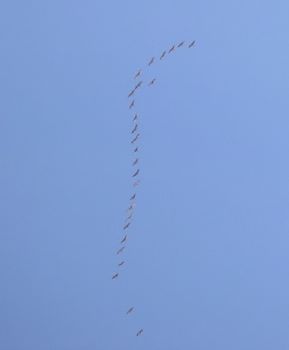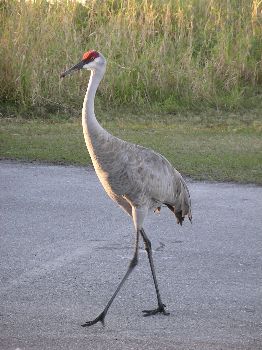
Sandhill Cranes over Austin, TX
March, 2004
An ancient group of birds, cranes evolved earlier than most other avian families and are seemingly at the end of their long history, with most populations declining. There are only 15 species worldwide and North America has just two: the sandhill and the whooping. While the sandhill population is still fairly large, the whooping cranes are barely back from the verge of extinction.
 Sandhill Cranes over Austin, TX March, 2004 |
One incident which I didn't properly appreciate at the time, but nonetheless left its mark on my memory, occurred in Florida around 1980 or so. I can't remember the exact place or time or even how I came to be kayaking alone on a large open lake, but I still distinctly recall coming around the edge of the tall grasses and reeds near the shoreline and suddenly seeing a tall, brilliant white bird. I knew immediately that it was a whooping crane, easily distinguishable from other white wading birds such as egrets. The crane was not particularly wary and simply moved off into the vegetation, without flying away as many birds will do. I thought it was neat to see the crane, but was unaware that they were nearly extinct at that time.
The only other time I saw whooping cranes was when touring the Aransas National Wildlife Refuge, which is now famous as a wintering ground for a few of the rare birds.
Sandhill cranes are much more likely to be seen by the casual observer. I've noticed them in the dunes along the Texas coast and frequently encounter them when traveling in Florida. They are also quite visible up in Wisconsin during the summer. While many birds migrate, few do it with as much flamboyance as the sandhill cranes.
Here in Austin, we are directly under the flyway of the cranes that travel between the Gulf coast and areas to the northwest of us. We sometimes see cranes flying high overhead during both the spring and autumn migrations. Often so high that they are hard to make out, the one thing that alerts us to their presence is their constant vocalizations. The distinctive warbling cry carries long distances and sounds like nothing else. From our yard, we've watched cranes as their V-formations approach over the edge of the trees that surround us, catch a rising thermal and form tight spirals as they fly higher and higher, then launch off the lift and continue on their way, much higher than before, ready to glide for miles before having to gain more altitude.
 Sandhill Crane at Myakka River State Park, FL, Feb., 2004 |
One particularly spectacular sighting happened a few years ago while I was still teaching in Pflugerville. The school is located on old farmland and there are few trees, with perfect visibility of the entire sky from one horizon to the other. I happened to make a trip out to my car during a break and heard the familiar sound of cranes. When I looked up, there was not just a flock or two, but an entire parade of birds, stretching from as far as I could see in the southeast to the northwest. All the birds were in V-formations, with dozens in each group. The fantastic thing was that there were hundreds of groups. It really looked like an avian superhighway across the sky. As it was lunchtime, I informed my colleagues of the spectacle and we all stood outside for at least 10 minutes watching the cranes pass overhead.
As breathtaking as watching distant flights can be, nothing beats a close-up encounter. This past February, I traveled to Myakka River State Park in Florida with my mother and we saw our share of sandhill cranes. Besides the distant birds feeding along the shores of the shallow lake, we also saw a single bird asleep on its nest, out in the middle of a flooded field along a backwoods trail. But the best sighting was of a particularly brazen individual crane that has figured out it has nothing to fear from the fishermen and all sorts of handouts to gain. I was riding my bike through the marina parking lot when this crane calmly walked right across the pavement in front of me, giving me no more than a passing glance as it claimed right-of-way.